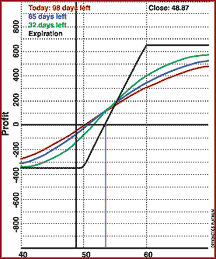OPTIONS
Unlikely Events Can Be Costly
Hidden Risks Of Debit Spreads
by Alex Mendoza
Understand all your risks when you trade. Strategies that seem harmless could end up costing you.
Debit spreads are a favorite strategy among experienced options traders who understand the need to hedge risk, however strong their directional convictions. For example, if the price of the underlying instrument rises, instead of profiting from a simple call, you can hedge the risk of the total cost of the option by selling another call at a higher strike price. This would lower the cost basis of your trade. The tradeoff for the lower risk is that profits are limited to the difference between the strikes minus the initial debit.
On the surface, common sense would lead you to believe that the risk
in all debit spreads is limited to the debit of the trade. But the way
assignment takes place in American-style, cash-settled options is such
that any short option position, even within the confines of a spread, will
give the holder of the trade unlimited risk -- even a position as seemingly
harmless as a bull call spread.

FIGURE 1: MICROSOFT BULL CALL SPREAD. Your maximum risk is limited to the debit that you paid for the spread, which in this case is $350 per spread. The maximum reward is $650 per spread.
AMERICAN VS. EUROPEAN
There are two types of exercise with standard options: European and American. European-style options cannot be exercised until their expiration date. That does not mean they cannot be sold and closed out, but a trader who is short a European option does not risk early assignment. On the other hand, American-style options can be exercised at any point during the life of the option. That uncertainty opens the door to high risks in some positions, even those that are often considered to be low-risk.
...Continued in the March 2003 issue of Technical Analysis of STOCKS & COMMODITIES.
Excerpted from an article originally published in the March 2003 issue of Technical Analysis of STOCKS & COMMODITIES magazine. All rights reserved. © Copyright 2003, Technical Analysis, Inc.